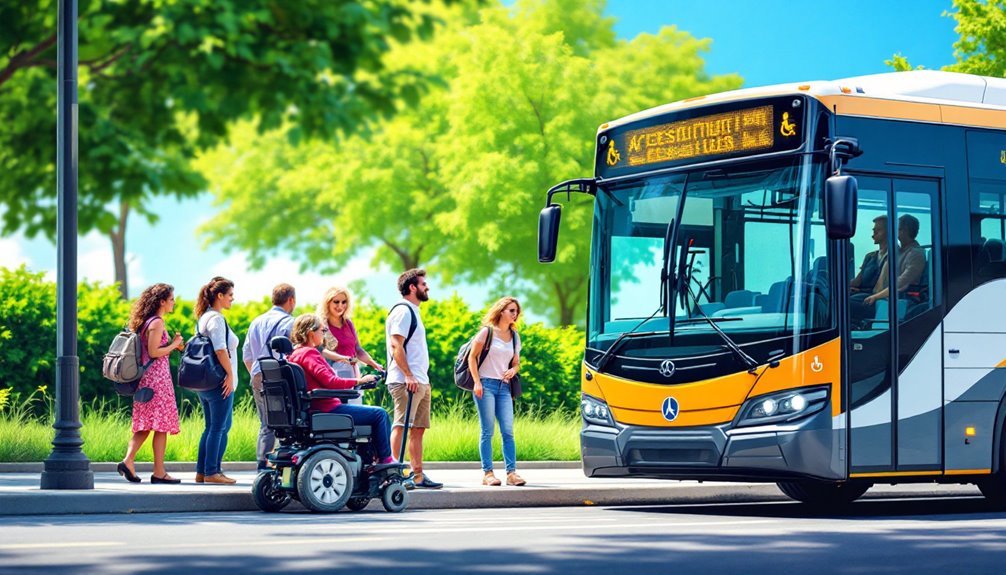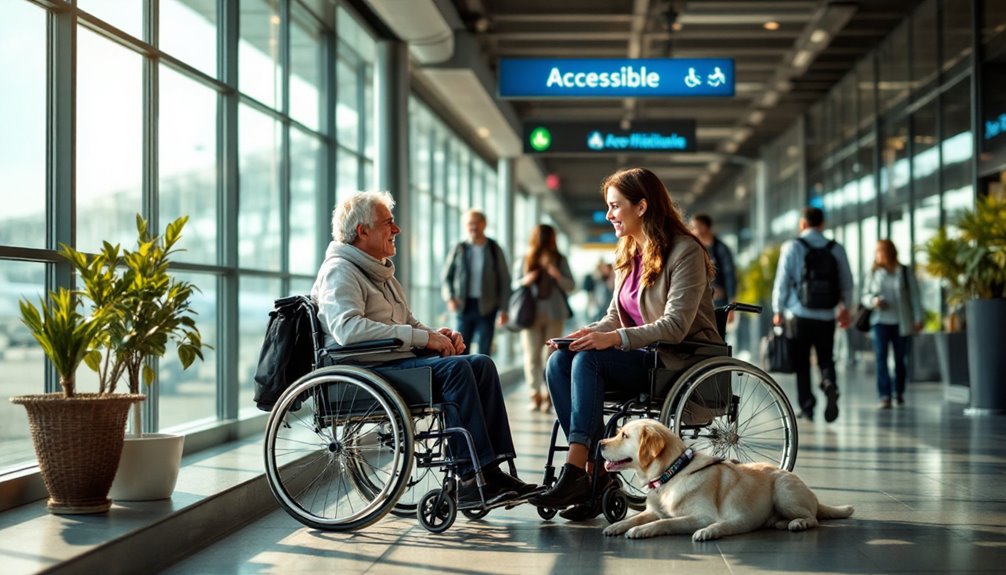When you think about writing for travelers with disabilities, you're tapping into an essential area of accessible tourism that often gets overlooked. It's not merely about sharing information; it's about empowering individuals to explore the world confidently. You'll need to take into account everything from transportation options to accommodations that genuinely cater to diverse needs. But what does it take to craft guides that don't only inform but also inspire? Understanding these nuances is key to making a real difference in how accessibility is perceived and implemented in travel. So, where do you start?
Importance of Research and Planning
When planning a trip, thorough research and preparation are key to ensuring a smooth experience for travelers with disabilities. You'll want to dive deep into the accessibility resources available at your destination. Start by checking the width of doorways, accessible bathrooms, and whether there are ramps or elevators in your accommodations. Don't forget to look into tours or activities to see if they cater to your needs, too.
Websites like wheelmap.org are great for finding crowdsourced information on accessible locations, while travel apps like AccessNow can help you locate venues in real-time. Ensure you're comfortable maneuvering through these digital tools, as information about infrastructure can be scattered and tricky to sift through. Additionally, many companies offer verified accessibility information to help you make informed choices about your accommodations and activities.
You can also get valuable insights from travel blogs and forums run by other disabled travelers, sharing firsthand experiences that could save you from potential headaches. Remember, customizing your travel plans is essential—tailor your itinerary to match your interests and abilities. This way, you'll enjoy everything from historical sites to world-class dining without worrying about accessibility. A little research goes a long way in making your adventure enjoyable and memorable!
Navigating Accessible Transportation
Choosing the right transportation can greatly impact your travel experience. When finding accessible transportation, you'll want to keep a few key points in mind. First, most public transit systems must meet ADA requirements, meaning they should have accessible routes for you to use. Look for bus stops and train stations featuring ramps, elevators, and accessible seating. Additionally, it's important to note that emerging technologies are being developed to enhance accessibility in transit services.
If you can't use fixed-route systems due to your disability, don't worry! You can rely on paratransit services, which offer complementary options to help you get around. Just remember, you'll need to apply and be determined eligible for these services, so it's smart to plan ahead.
Also, consider using technology like apps that can guide you, especially if you have visual impairments. These tools can be a lifesaver, offering real-time information about your journey.
Finding accessible transportation doesn't have to be stressful. With a little research, you can find the right services and features that meet your needs. So, buckle up and get ready to explore, knowing there are options out there tailored for you!
Types of Accessible Travel Options

Accessible travel options come in various forms, ensuring you can enjoy your trip with comfort and convenience. When it comes to adaptive accommodations, you've got plenty of choices. Many hotels now offer rooms with accessible bathtubs, roll-in showers, and grab bars. If you prefer something cozier, vacation rentals on platforms like Airbnb and Vrbo often have features like ramps and wide doorways. You might even find welcoming bed and breakfasts or hostels with accessible rooms ready to host you.
As for inclusive activities, think beyond the ordinary. You can join accessible walking tours, where guides use audio descriptions to enhance your experience. Want a taste of culture? Look for accessible theater performances or concerts tailored for those with visual or hearing impairments. Nature lovers can explore national parks with well-maintained trails, while adventure seekers can try adaptive sports like wheelchair hiking or sailing. Additionally, many destinations are now focusing on creating inclusive environments to ensure that all travelers can enjoy equal experiences.
Understanding Market Trends
As the demand for inclusive travel services continues to rise, understanding market trends in accessible travel becomes essential for both travelers and businesses. You might be surprised to learn that the global accessible travel market is valued at a whopping USD 35.6 billion in 2024, with a projected growth rate of 13.4% annually! This growth isn't just a number; it's driven by a rising aging population and increasing awareness of accessibility needs. Additionally, increased investments from airlines and local governments are facilitating improvements in accessible infrastructure.
North America leads the charge, thanks to its solid infrastructure and government support, while Europe keeps pace with initiatives to improve accessibility. Meanwhile, Asia Pacific is experiencing rapid growth as countries invest in accessible services, opening up exciting market opportunities for everyone involved.
The economic and social benefits of accessible travel are significant. With 1.3 billion people living with disabilities globally, this market represents a huge audience. Plus, travelers with disabilities often bring along friends and family, boosting tourism revenues. And let's not forget the role of accessibility innovations, like mobile apps and virtual reality, which are making travel easier and more enjoyable for all. So, whether you're planning a trip or running a business, now's the time to pay attention to these trends!
Community and Public Transit Features

When maneuvering public transit, the importance of community features designed for accessibility can't be overstated. You'll find that upgraded infrastructure makes a big difference. Elevators and ramps at stations help you avoid the dreaded stairs, while tactile warning strips guide visually impaired riders like a trusty sidekick. Brightly colored floor decals? They're like road maps that show you where to wait for your train!
Advocacy initiatives have pushed for these changes, ensuring that public transit keeps evolving. Community outreach programs also play a role, helping to gather feedback from riders like you. Have you tried using accessible apps? They're designed to make your travel easier, providing wayfinding solutions and real-time information. Additionally, many transit systems offer publications that outline their accessibility features and improvements.
And let's not forget about the buses! Many are equipped with low floors, kneeling features, and room for mobility devices. It's all about making sure you can hop on without feeling like you're auditioning for a gymnastics team. Plus, drivers receive training to assist you, so you're not left hanging. With these community and public transit features, it's clear that the journey can be smoother for everyone.
Daily Travel Patterns Insights
Traveling daily presents unique patterns for people with disabilities. Your travel behavior likely differs from those without disabilities, and understanding these trip characteristics can help one navigate daily routines better. On average, one might find oneself making fewer trips each day. For instance, if one is a worker with a disability, one typically makes about 1.7 trips, while their non-disabled peers make around 2.3. Non-workers with disabilities average just 1.1 trips, compared to 2.0 for those without disabilities.
When it comes to transportation, one might rely more on walking or being a passenger in vehicles rather than driving themselves. Public transit isn't as popular among one's peers either, especially those over 65. One probably also notices that their trips tend to be shorter—about 9.4 miles for workers with disabilities versus 12 miles for those without. Sometimes, one might take a bit longer to travel, which can feel frustrating. Many individuals even limit their travel to daytime or rely on rides from others. Recognizing these patterns can empower one to plan more effectively and make the most of their journeys, no matter the distance! Moreover, it's essential to consult with a physician to ensure that health needs are considered during travel planning.
Tips for Effective Communication

Effective communication plays an essential role in ensuring that travelers with disabilities feel supported and informed throughout their journey. To make your travel experience smoother, you should look for various formats of information, like accessible electronic text, large print, and audio formats. These options can help you understand the available assistance devices and services.
When you're at the airport, inclusive signage is essential. It should be clear and visible, combining words and pictograms to cater to different needs. Keep an eye out for floor graphics that guide you, especially if you're using a wheelchair. If you're unsure, don't hesitate to ask roving ambassadors for help—they're there to assist you with navigation and communication.
Before your trip, check the airline's website for detailed information on accessibility features, including how to communicate using text, email, or video relay. This preparation can make a big difference in your travel experience. Additionally, many transportation providers now follow accessibility standards to enhance information communication for travelers with disabilities. Finally, remember that feedback is important. If you notice something that could be improved, speak up! Your voice helps shape a more inclusive travel environment for everyone. Happy travels!
Wrapping up
So, don't let the fear of limitations hold you back from exploring the world. With a little research and planning, you can find accessible options that suit your needs perfectly. Remember, it's more than merely about getting from point A to point B; it's about enjoying the journey and creating unforgettable memories. Whether you're hopping on a bus or checking into a hotel, the right resources are out there, ready to help you make the most of your adventure!